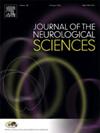Neurofilament light chain and Alzheimer pathology biomarkers in elderly people with multiple sclerosis
IF 3.6
3区 医学
Q1 CLINICAL NEUROLOGY
引用次数: 0
Abstract
Objectives
Neurofilament light chain (NfL) conventionally reflects disability worsening in multiple sclerosis (MS), but does not necessarily imply MS-specific mechanisms and could be affected by biological or pathological aging, including Alzheimer disease (AD) pathology. We aim to evaluate clinical correlates of plasma NfL (pNfL) in elderly patients with MS, and its associations with AD plasma biomarkers.
Methods
We recruited consecutive people with MS >65 years, and collected expanded disability status scale (EDSS), current disease modifying treatment (DMT) and years of exposure to DMTs. Cognitive function was assessed using the Symbol Digit Modalities Test (SDMT), the California Verbal Learning Test-II (CVLT-II), and the Brief Visuospatial Memory Test-Revised (BVMTR). Plasma biomarkers (Aβ40, Aβ42, p-Tau181, and pNfL) were measured using LUMIPULSE assay kits on the CLEIA analyser LUMIPULSE G600II.
Results
We included 83 elderly adults (age 68.8 ± 3.1 years; females 65.8 %) with MS (EDSS 5.5 (2.0–8.0)). On linear regression models adjusted for age, sex, BMI, smoking status, and cardiovascular risk factors, there were no associations between pNfL and EDSS, type and duration of DMT exposure, SDMT, CVLT, and BVMRT. Higher pNfL was associated with lower plasma Aβ40 (Coeff = −0.40; 95 %CI = -0.66, −0.14; p = 0.003), plasma Aβ42 (Coeff = −4.46; 95 %CI = -7.92, −1.00; p = 0.01), and Aβ42/Aβ40 ratio (Coeff = −2612.06; 95 %CI = -4114.76, −1109.36; p = 0.001). Also, lower Aβ42/Aβ40 ratio was associated with impaired CVLT (Coeff = −0.021; 95 %CI = -0.036, −0.006; p = 0.007).
Interpretation
pNfL in elderly people with MS is associated with biomarkers of amyloid accumulation, which in turn are associated with cognitive impairments, suggesting overlapping pathologies between MS and AD.
老年多发性硬化症患者的神经丝轻链和阿尔茨海默病病理标志物
神经丝轻链(NfL)通常反映多发性硬化症(MS)的残疾恶化,但并不一定意味着MS特异性机制,并且可能受到包括阿尔茨海默病(AD)病理在内的生物或病理性衰老的影响。我们的目的是评估老年MS患者血浆NfL (pNfL)的临床相关性及其与AD血浆生物标志物的相关性。方法连续招募65岁的多发性硬化患者,收集扩展残疾状态量表(EDSS)、当前疾病改善治疗(DMT)和DMT暴露年数。采用符号数字模态测试(SDMT)、加州语言学习测试(CVLT-II)和简短视觉空间记忆测试(BVMTR)评估认知功能。血浆生物标志物(a - β40、a - β42、p-Tau181和pNfL)在CLEIA LUMIPULSE G600II分析仪上使用LUMIPULSE检测试剂盒进行检测。结果纳入83例老年人(年龄68.8±3.1岁;女性65.8%)伴MS (EDSS 5.5(2.0-8.0))。在调整了年龄、性别、BMI、吸烟状况和心血管危险因素的线性回归模型中,pNfL与EDSS、DMT暴露类型和持续时间、SDMT、CVLT和BVMRT之间没有关联。较高的pNfL与较低的血浆Aβ40相关(Coeff = - 0.40;95% ci = -0.66, - 0.14;p = 0.003),血浆Aβ42 (Coeff = - 4.46;95% ci = -7.92, - 1.00;p = 0.01),β42 /β40比例(多项式系数=−2612.06;95% ci = -4114.76, - 1109.36;p = 0.001)。此外,较低的a - β42/ a - β40比值与CVLT受损相关(Coeff =−0.021;95% ci = -0.036, - 0.006;p = 0.007)。老年多发性硬化症患者的nfl与淀粉样蛋白积累的生物标志物有关,淀粉样蛋白积累反过来又与认知障碍有关,这表明多发性硬化症和AD之间存在重叠的病理。
本文章由计算机程序翻译,如有差异,请以英文原文为准。
求助全文
约1分钟内获得全文
求助全文
来源期刊

Journal of the Neurological Sciences
医学-临床神经学
CiteScore
7.60
自引率
2.30%
发文量
313
审稿时长
22 days
期刊介绍:
The Journal of the Neurological Sciences provides a medium for the prompt publication of original articles in neurology and neuroscience from around the world. JNS places special emphasis on articles that: 1) provide guidance to clinicians around the world (Best Practices, Global Neurology); 2) report cutting-edge science related to neurology (Basic and Translational Sciences); 3) educate readers about relevant and practical clinical outcomes in neurology (Outcomes Research); and 4) summarize or editorialize the current state of the literature (Reviews, Commentaries, and Editorials).
JNS accepts most types of manuscripts for consideration including original research papers, short communications, reviews, book reviews, letters to the Editor, opinions and editorials. Topics considered will be from neurology-related fields that are of interest to practicing physicians around the world. Examples include neuromuscular diseases, demyelination, atrophies, dementia, neoplasms, infections, epilepsies, disturbances of consciousness, stroke and cerebral circulation, growth and development, plasticity and intermediary metabolism.
 求助内容:
求助内容: 应助结果提醒方式:
应助结果提醒方式:


